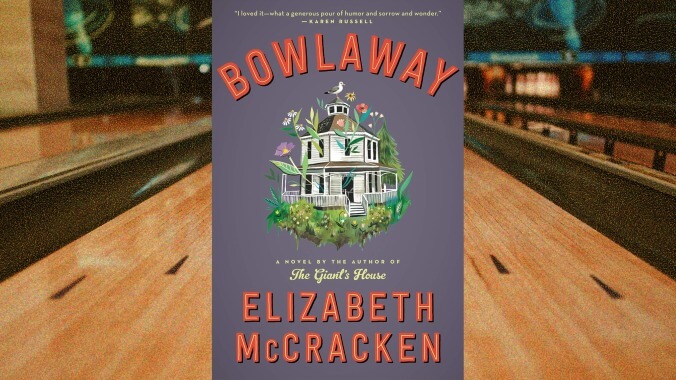A stranger comes to town—and opens a bowling alley—in Elizabeth McCracken’s Bowlaway
Aux Features Book Review
In Elizabeth McCracken’s novel Bowlaway, the recently widowed Dr. Leviticus Sprague writes a biography of his wife, Bertha Truitt, and sends it to a publisher. His work is rejected and sent back with “an irritated note: yes, yes, but to what end?” It’s a similar sentiment to the one expressed in the first pages of McCracken’s 1996 debut novel, The Giant’s House, where the misanthropic narrator scoffs at the idea of oral histories or interviews with senior citizens being interesting. What could make the life of one person worth writing or reading about to anyone but the people directly connected to them?
Bowlaway asks and answers this question by tracing Bertha’s life and lasting impact on the small town of Salford, Massachusetts. The eccentric Bertha is cagey about her past from the very beginning; she’s found unconscious in the town cemetery carrying a bag filled with gold and equipment for candlepin bowling, which she claims to have invented. She relentlessly builds a future by opening up a bowling alley that serves as a locus of activity for the novel and its eccentric cast of orphans, outcasts, veterans, hustlers, and ghost hunters.
McCracken has a distinctly rambling and lyrical style, her story flowing among characters and periodically dropping hints about their final fates well before the narrative catches up. Characters alternately describe candlepin bowling as a sport of skill and precision and one of luck where you might be fortunate enough to score a spare based on the arbitrary spin of the pins. McCracken’s prose similarly flows according to a clear plan, but then, like a rogue ball, veers off course. Sometimes McCracken hits her mark, delivering a surprisingly tender scene or laugh-out-loud funny line, while some of her passages don’t connect to anything at all.
The story begins at the turn of the 20th century and flows through the ’50s, chronicling how Bertha’s alley and the people who work, live, and play there are affected by both major events, of the two World Wars and the Great Depression, and also the subtler forces of age, love, and technology. Bertha is a wonderful character, bucking all tradition as she encourages the women of Salford to bowl with her without any separation from the male patrons, and she marries Sprague despite the scandal caused by a white woman wedding a black man. Though very real, her mysterious past and obstinate habits make her as much a creature of speculation as the local cryptid, the Salford Devil. Bowlaway blends portraits of largely mundane people with a bit of magical realism, periodically sharing stories of strange dreams, spontaneous combustion, and sightings of monsters and UFOs. Some of these phenomena are explained as being caused by humans, if strange ones; others are left as mysterious as Bertha’s past.
Genealogy is a running theme throughout the book, with several characters who don’t speak about or know their families but who wish to better understand themselves. As McCracken notes, most people trace their family trees hoping to find something special like a royal distant cousin. But Bowlaway’s narrative tree only gets weaker as its branches stray further from the solid roots provided by Bertha’s story. It’s a real shame that the novel is just never as good after its first half, when the story’s matriarch is a direct actor and not just a progenitor to other characters and narratives. Some characters simply can’t reconcile with Bertha’s death, and the book itself never really recovers either.
Bowlaway strives nobly to articulate the lives of each of its characters and provides some other wonderful portraits. There’s LuEtta Mood, who becomes known as the Angel Of The Alley for her beauty and skill and finds respite in the sport’s distraction from her lost baby and unhappy marriage. There’s Joe Wear, who first discovers Bertha in the cemetery and winds up being named by her to run the alley. “She had known from the moment she’d met him that he was a bowler to his very soul. He had that knack for pointless devotion,” McCracken writes. Even Nahum Truitt, the misogynist fraud who appears in Salford following Bertha’s death hoping to claim her legacy, isn’t fully painted as a villain, his character tempered by love and loss.
The story orbits the bowling alley and devotes time to characters according to their impact on it, even if they don’t seem like they’re star material for a novel. McCracken devotes plenty of pages to Bertha’s ex-maid, Margaret, but precious few to Bertha’s biracial daughter, Minna, who leaves Salford to travel the world as a singer and percussionist; her story is too extraordinary. McCracken instead has pieced together a series of small dramas that sometimes line up like perfectly set pins and sometimes feel as frustratingly separated as a seven-ten split.
2 Comments
I remember reading, Here’s You Hat, What’s Your Hurry, in high school and loving it. Her short stories were/are fantastic and worth seeking out.
I met Ms. McCracken once about 15 years ago when she gave a talk at the public library. She was very nice. FACT.